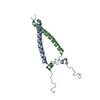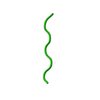[English] 日本語
 Yorodumi
Yorodumi- PDB-7dwv: Cryo-EM structure of amyloid fibril formed by familial prion dise... -
+ Open data
Open data
- Basic information
Basic information
| Entry | Database: PDB / ID: 7dwv | ||||||
|---|---|---|---|---|---|---|---|
| Title | Cryo-EM structure of amyloid fibril formed by familial prion disease-related mutation E196K | ||||||
 Components Components | Major prion protein | ||||||
 Keywords Keywords | PROTEIN FIBRIL / Amyloid fibril | ||||||
| Function / homology |  Function and homology information Function and homology informationnegative regulation of amyloid precursor protein catabolic process / regulation of glutamate receptor signaling pathway / lamin binding / aspartic-type endopeptidase inhibitor activity / regulation of calcium ion import across plasma membrane / positive regulation of glutamate receptor signaling pathway / glycosaminoglycan binding / NCAM1 interactions / type 5 metabotropic glutamate receptor binding / ATP-dependent protein binding ...negative regulation of amyloid precursor protein catabolic process / regulation of glutamate receptor signaling pathway / lamin binding / aspartic-type endopeptidase inhibitor activity / regulation of calcium ion import across plasma membrane / positive regulation of glutamate receptor signaling pathway / glycosaminoglycan binding / NCAM1 interactions / type 5 metabotropic glutamate receptor binding / ATP-dependent protein binding / negative regulation of interleukin-17 production / cupric ion binding / regulation of potassium ion transmembrane transport / negative regulation of protein processing / negative regulation of dendritic spine maintenance / dendritic spine maintenance / negative regulation of calcineurin-NFAT signaling cascade / extrinsic component of membrane / negative regulation of interleukin-2 production / Insertion of tail-anchored proteins into the endoplasmic reticulum membrane / negative regulation of T cell receptor signaling pathway / negative regulation of activated T cell proliferation / negative regulation of amyloid-beta formation / response to amyloid-beta / negative regulation of type II interferon production / cuprous ion binding / negative regulation of long-term synaptic potentiation / intracellular copper ion homeostasis / positive regulation of protein targeting to membrane / long-term memory / response to cadmium ion / inclusion body / neuron projection maintenance / positive regulation of calcium-mediated signaling / tubulin binding / molecular function activator activity / cellular response to copper ion / positive regulation of protein localization to plasma membrane / molecular condensate scaffold activity / protein homooligomerization / protein destabilization / cellular response to xenobiotic stimulus / cellular response to amyloid-beta / terminal bouton / positive regulation of neuron apoptotic process / signaling receptor activity / protein-folding chaperone binding / amyloid-beta binding / response to oxidative stress / protease binding / nuclear membrane / microtubule binding / molecular adaptor activity / transmembrane transporter binding / learning or memory / postsynapse / regulation of cell cycle / postsynaptic density / intracellular signal transduction / membrane raft / copper ion binding / external side of plasma membrane / intracellular membrane-bounded organelle / dendrite / negative regulation of apoptotic process / protein-containing complex binding / cell surface / endoplasmic reticulum / negative regulation of transcription by RNA polymerase II / Golgi apparatus / extracellular exosome / identical protein binding / plasma membrane / cytosol / cytoplasm Similarity search - Function | ||||||
| Biological species |  Homo sapiens (human) Homo sapiens (human) | ||||||
| Method | ELECTRON MICROSCOPY / helical reconstruction / cryo EM / Resolution: 3.07 Å | ||||||
 Authors Authors | Wang, L.Q. / Zhao, K. / Yuan, H.Y. / Li, X.N. / Dang, H.B. / Ma, Y.Y. / Wang, Q. / Wang, C. / Sun, Y.P. / Chen, J. ...Wang, L.Q. / Zhao, K. / Yuan, H.Y. / Li, X.N. / Dang, H.B. / Ma, Y.Y. / Wang, Q. / Wang, C. / Sun, Y.P. / Chen, J. / Li, D. / Zhang, D.L. / Yin, P. / Liu, C. / Liang, Y. | ||||||
 Citation Citation |  Journal: Sci Adv / Year: 2021 Journal: Sci Adv / Year: 2021Title: Genetic prion disease-related mutation E196K displays a novel amyloid fibril structure revealed by cryo-EM. Authors: Li-Qiang Wang / Kun Zhao / Han-Ye Yuan / Xiang-Ning Li / Hai-Bin Dang / Yeyang Ma / Qiang Wang / Chen Wang / Yunpeng Sun / Jie Chen / Dan Li / Delin Zhang / Ping Yin / Cong Liu / Yi Liang /  Abstract: Prion diseases are caused by the conformational conversion of prion protein (PrP). Forty-two different mutations were identified in human PrP, leading to genetic prion diseases with distinct clinical ...Prion diseases are caused by the conformational conversion of prion protein (PrP). Forty-two different mutations were identified in human PrP, leading to genetic prion diseases with distinct clinical syndromes. Here, we report the cryo–electron microscopy structure of an amyloid fibril formed by full-length human PrP with E196K mutation, a genetic Creutzfeldt-Jakob disease–related mutation. This mutation disrupts key interactions in the wild-type PrP fibril, forming an amyloid fibril with a conformation distinct from the wild-type PrP fibril and hamster brain–derived prion fibril. The E196K fibril consists of two protofibrils. Each subunit forms five β strands stabilized by a disulfide bond and an unusual hydrophilic cavity stabilized by a salt bridge. Four pairs of amino acids from opposing subunits form four salt bridges to stabilize the zigzag interface of the two protofibrils. Our results provide structural evidences of the diverse prion strains and highlight the importance of familial mutations in inducing different strains. | ||||||
| History |
|
- Structure visualization
Structure visualization
| Movie |
 Movie viewer Movie viewer |
|---|---|
| Structure viewer | Molecule:  Molmil Molmil Jmol/JSmol Jmol/JSmol |
- Downloads & links
Downloads & links
- Download
Download
| PDBx/mmCIF format |  7dwv.cif.gz 7dwv.cif.gz | 68.4 KB | Display |  PDBx/mmCIF format PDBx/mmCIF format |
|---|---|---|---|---|
| PDB format |  pdb7dwv.ent.gz pdb7dwv.ent.gz | 43.7 KB | Display |  PDB format PDB format |
| PDBx/mmJSON format |  7dwv.json.gz 7dwv.json.gz | Tree view |  PDBx/mmJSON format PDBx/mmJSON format | |
| Others |  Other downloads Other downloads |
-Validation report
| Summary document |  7dwv_validation.pdf.gz 7dwv_validation.pdf.gz | 723.7 KB | Display |  wwPDB validaton report wwPDB validaton report |
|---|---|---|---|---|
| Full document |  7dwv_full_validation.pdf.gz 7dwv_full_validation.pdf.gz | 729 KB | Display | |
| Data in XML |  7dwv_validation.xml.gz 7dwv_validation.xml.gz | 21.5 KB | Display | |
| Data in CIF |  7dwv_validation.cif.gz 7dwv_validation.cif.gz | 31.1 KB | Display | |
| Arichive directory |  https://data.pdbj.org/pub/pdb/validation_reports/dw/7dwv https://data.pdbj.org/pub/pdb/validation_reports/dw/7dwv ftp://data.pdbj.org/pub/pdb/validation_reports/dw/7dwv ftp://data.pdbj.org/pub/pdb/validation_reports/dw/7dwv | HTTPS FTP |
-Related structure data
| Related structure data |  30887MC M: map data used to model this data C: citing same article ( |
|---|---|
| Similar structure data |
- Links
Links
- Assembly
Assembly
| Deposited unit | 
|
|---|---|
| 1 |
|
- Components
Components
| #1: Protein | Mass: 22996.422 Da / Num. of mol.: 6 / Mutation: E196K Source method: isolated from a genetically manipulated source Source: (gene. exp.)  Homo sapiens (human) / Gene: PRNP, ALTPRP, PRIP, PRP / Production host: Homo sapiens (human) / Gene: PRNP, ALTPRP, PRIP, PRP / Production host:  Has protein modification | Y | |
|---|
-Experimental details
-Experiment
| Experiment | Method: ELECTRON MICROSCOPY |
|---|---|
| EM experiment | Aggregation state: HELICAL ARRAY / 3D reconstruction method: helical reconstruction |
- Sample preparation
Sample preparation
| Component | Name: Human prion E196K mutation amyloid fibril / Type: ORGANELLE OR CELLULAR COMPONENT / Entity ID: all / Source: RECOMBINANT |
|---|---|
| Source (natural) | Organism:  Homo sapiens (human) Homo sapiens (human) |
| Source (recombinant) | Organism:  |
| Buffer solution | pH: 5 |
| Specimen | Embedding applied: NO / Shadowing applied: NO / Staining applied: NO / Vitrification applied: YES |
| Vitrification | Cryogen name: ETHANE |
- Electron microscopy imaging
Electron microscopy imaging
| Experimental equipment |  Model: Titan Krios / Image courtesy: FEI Company |
|---|---|
| Microscopy | Model: FEI TITAN KRIOS |
| Electron gun | Electron source:  FIELD EMISSION GUN / Accelerating voltage: 300 kV / Illumination mode: FLOOD BEAM FIELD EMISSION GUN / Accelerating voltage: 300 kV / Illumination mode: FLOOD BEAM |
| Electron lens | Mode: BRIGHT FIELD |
| Image recording | Electron dose: 64 e/Å2 / Film or detector model: GATAN K2 SUMMIT (4k x 4k) |
- Processing
Processing
| CTF correction | Type: NONE |
|---|---|
| Helical symmerty | Angular rotation/subunit: 179.657 ° / Axial rise/subunit: 2.40873 Å / Axial symmetry: C1 |
| 3D reconstruction | Resolution: 3.07 Å / Resolution method: FSC 0.143 CUT-OFF / Num. of particles: 24083 / Symmetry type: HELICAL |
 Movie
Movie Controller
Controller







 PDBj
PDBj


